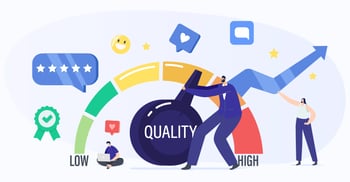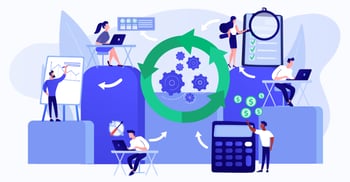10 Secrets To Help You Reduce Customer Churn Fast

If you sell SaaS online, you know that customer churn is terrible news. Lowering churn can improve almost everything related to subscription revenue ‒ from your Lifetime Value (LTV) to your SaaS Customer Acquisition Cost (CAC) payback period and your growth rate. Researchers at Bain & Company found that increasing customer retention by just 5% can increase profits by a whopping 25-95%.
But how do you go about reducing customer churn rates efficiently? Is dunning management an option? How about customer service? This article contains all the insider secrets and techniques you will need.fWhat Is Customer Churn?
In the SaaS business world, customer churn (also called “attrition rate”) is the number of customers who cancel their subscription to a product or service over a certain period. The rate of customer churn is usually measured as a percentage. This is what the equation looks like:
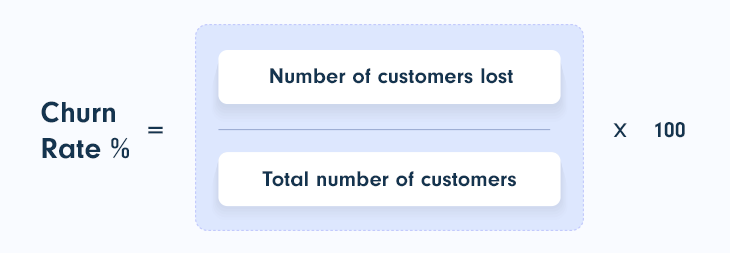
For example, if you sell software online and your business had 800 customers at the beginning of the quarter, and you lost 40 of them by the end of the quarter, you would have a 5% customer churn rate. Evaluating your customer churn rate is vital to consider when you’re assessing your SaaS retention strategy. A high churn rate means it’s time to nurture your existing customers and improve the product, service, or experience you offer.
Why a High Churn Rate Is Risky
A high customer churn rate means your business is losing customers and, therefore, revenue. The high churn can also make it hard to cover your CAC payback and generate a good cash flow. Ultimately, it will hinder your company's growth.
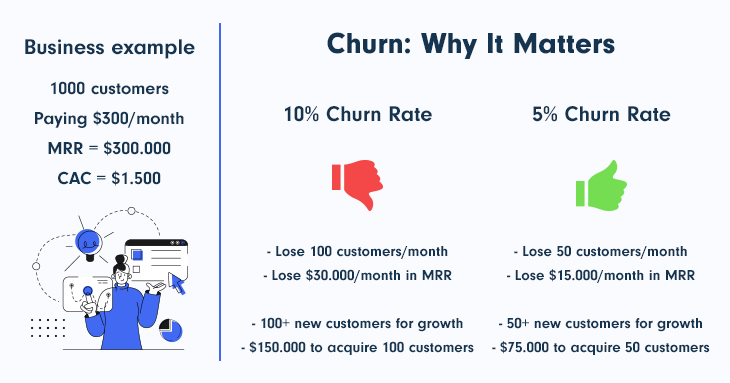
How Do I Know If My Churn Is Cause for Concern?
A little churn is natural for SaaS businesses operating in a highly competitive environment. About 5-7% is considered within the “healthy” range of monthly churn, though this is quite a general estimate within the industry. If your customer churn rate is within this range, you’re probably able to balance it out by acquiring new customers or expanding your current customer base.
Warning Signs To Look Out For:
A high churn rate can be a sign of something bigger, like underlying problems with your product or service or even billing issues. Customers often churn because of poor onboarding, a low-quality product, or a lack of access to an effective customer support team. It’s therefore vitally important to keep an eye on this rate.
You may find you have a problem if:
Your churn is happening faster than you can sign on customers
Your LTV is shrinking
Your churn rate is above 10%
You’re experiencing more downgrades than upgrades from your customers
The 3 Stages of Customer Retention
Many businesses only turn their attention to churn once they’re losing customers. This is a reactive strategy that could cost you dearly. Being proactive against customer churn means starting at the moment of customer acquisition. There are three main stages to the lifecycle of customer retention. Understanding them as well as having an idea of what is net revenue retention will help to inform your strategy throughout the customer journey:
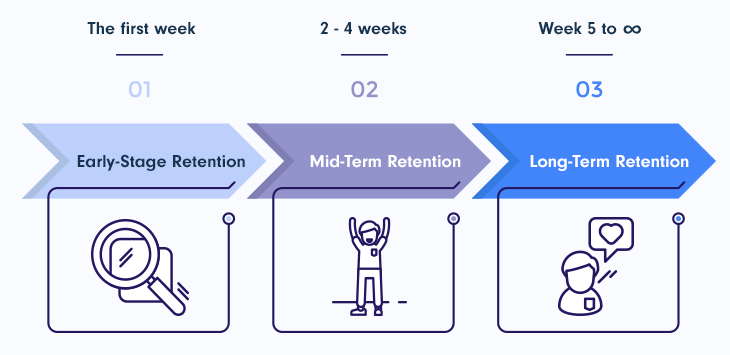
1. Early-Stage Retention
Early-stage retention usually refers to the first week a customer is engaging with your SaaS product or service. This stage tends to contain the most significant drop in retention. Here the focus should be on encouraging customers to use the product or service more than once, helping them find the benefits, and ultimately realize the value of what you offer.
2. Mid-Term Retention
Mid-term retention refers to the period of weeks two to four. These few weeks are vital as customers need to develop a usage pattern with the SaaS product or service. Building customer loyalty and engagement are critical at this stage. The more the product is integrated into a customer’s life and becomes a habit, the less likely they’ll churn.
No 3rd party integrations. No hidden costs. No wasted time.
Just a solution as unique as your business’s needs.
3. Long-Term Retention
Long-term retention runs from week five for the duration of the customer’s time with the business. Here, the focus is on making the product indispensable to the user and ensuring that they continue to receive value from it. Engaging customers in the early retention stages will most likely keep them around for the longer term. Making improvements in the later stages will also help you to sustain a good subscriber base over time.
How to Reduce Customer Churn
1. Focus on Your Onboarding Process
Your user onboarding needs to help you shorten time to value and get more customers to experience your product’s core value. The best way to do this is through your onboarding process. For a full breakdown of SaaS onboarding best practices, see our recent blog post.
Key Tips For Improving User Onboarding:
Speak to your customers’ desires and pain points.
Welcome new customers to the platform.
Use quick, simple, and intuitive processes.
Set achievable tasks.
Celebrate and reward customer success and progress.
Keep communication and support open and clear.
2. Strengthen Your Customer Relationships
If you build good relationships with customers and understand them, you’ll be able to continue providing users with a valuable product or service as time goes on. An honest and transparent relationship with a customer builds trust, trust builds loyalty, and loyal customers are far less likely to churn. This relationship-building process can start from the moment a user signs up for your SaaS product or service.
Key Tips For Improving Customer Relationships
Be quick to respond to complaints and queries.
Build a strong online community where users can interact and gain value.
Interview users for business tips and testimonials, and share these on your website and social media platforms.
Show your customers that they’re dealing with people and not a cold, faceless organization.
If you build solid relationships and a smooth customer experience, your users are more likely to reach out if there are problems and stick around while you address them. They’ll also be more likely to stay with you for longer periods and through other changes in their lives. And if they cancel their subscription, you’re more likely to get feedback on why they did it.
3. Identify At-Risk Users and Target Them
Part of being proactive about reducing churn is identifying “unhealthy” or “at-risk” users before they have a chance to cancel their subscriptions. To identify at-risk customers, you need to build a profile of these customers and use micro surveys to collect information to inform your retention strategy.
You can collect information about at-risk users by looking at churn indicators specific to your business. Two examples are your Net Promoter Score (NPS) and your customers’ engagement with your software. Read more about the most critical SaaS metrics here.
Poor customer service will only worsen your churn. However, when you prioritize proactive customer service, then your teams can make personal contact with at-risk customers to prevent customer churn by checking if they’re getting the necessary value from the product. Nothing is more effective at reducing churn than offering stellar customer service.
Also, have a good look at the users that aren’t using your product, those using it far less frequently, and those suddenly not engaging at all. Identifying these users means you can build a specific strategy to reach them and fix the root issue — sometimes before they realize there’s a problem.
4. Ask for Customer Feedback and Take Appropriate Action
Keeping lines of communication open with customers is vital for reducing churn. You need to understand why your customers love your product or why they’re choosing to cut ties with your business. Before asking for feedback, it is essential to focus on building an online community for a SaaS business. Here are some of the best ways to proactively ask for feedback at various stages of the customer journey.

Surveys
Surveys are a great way to collect customer feedback. However, the timing of surveys is vital. Send it out too early, and users aren’t yet invested in your product. One way to get around this is to offer incentives to encourage customer feedback. Calls for feedback also need to be subtle and only be done when relevant.
Your survey could include mostly open-ended questions such as why the customer has started using the product, what value they receive from it, and how you, as the business, can improve.
In-Product Micro Surveys
In-product micro surveys can also be effective, as they happen while the customer uses the product. Real-time feedback through chatbots and live chat are particularly effective, as this often allows for more detailed, personalized feedback.
Analyzing Feedback
Analyzing feedback is the best way to measure customer success and satisfaction while identifying where there’s room for improvement. An analysis is especially important if you receive negative feedback. If your customers feel unheard or see no change where they were dissatisfied, they’re more likely to churn.
Listen To Your Customer
Show your customers that you’re listening to them. Where there’s a widespread issue, communicate that you’ve received the feedback and that you’re addressing the problem. Once it’s addressed, share that too, completing the feedback loop. This approach will significantly improve loyalty and customer satisfaction.
Ask For Feedback
The other opportunity for meaningful feedback is when a customer cancels a subscription or doesn’t renew. A personalized email asking for feedback could lead to valuable insights into how to deliver a better product. Some customers may even be convinced to return to the product.
5. Analyze Churn by Customer Segment
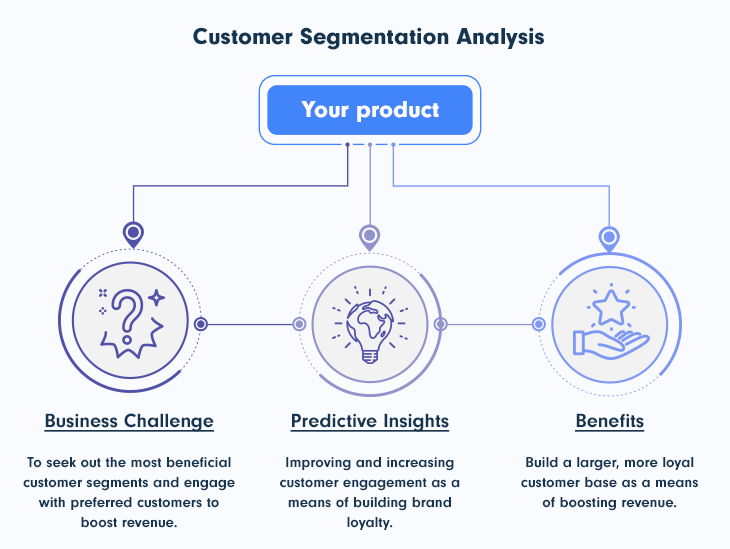
To work out where your churn is taking place, it’s worth analyzing your customer segments. Your segments are the different ways in which you group your customers. For example, segmentation could occur through the plans they’ve signed up for, their locations, ages, or any other relevant categories.
You may find that customers who sign up during a discount period are churning more than those who pay the full price or that customers on a specific pricing plan are canceling the most. Next, you can determine why this is happening and how to fix the problem. Maybe offering different pricing models, like the pay-per-seat option or usage-based billing, can improve your churn rates. Use our SaaS pricing guide to gain relevant insights.
In addition, segmenting users allows you to work on different approaches for customers who have been with your business for a couple of years and those who are new. Their needs may be very different.
Segmenting users can also help you identify which types of users aren’t a good fit for your company. Consequently, you can ensure that you’re not marketing to them and reduce the risk of having them increase your customer churn rate. Realign your subscription marketing and sales strategy around the various identified segments.
6. Identify and Reduce Activity Churn
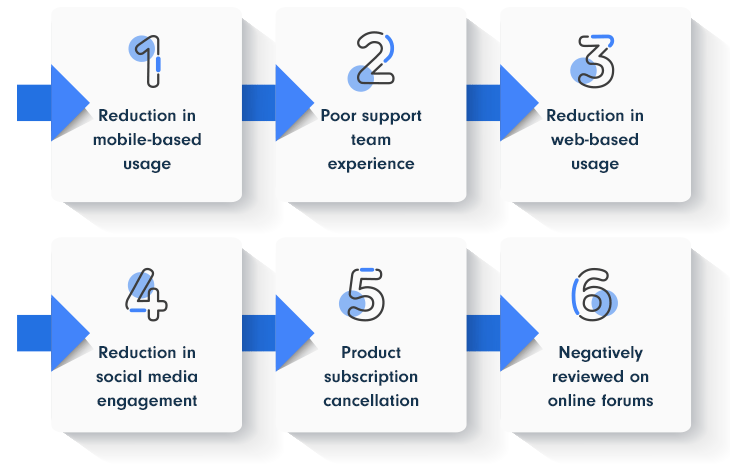
Activity churn is different from regular churn in that it focuses on the number of users that become inactive each month. It’s all well and good having a decent customer subscription base, but you don’t want to discover that some aren’t using your product enough or at all. These are often the users who’ll wake up one day and realize that they’ve stopped needing the product. Next, they’ll churn.
While segmenting customers and collecting usage data, go about collating detailed information on user activity. This can help you work out behavioral differences between your long-term customers and those that unsubscribe from the SaaS product or service. User activity can relate to the length of sessions, frequency of logins, number of logins, and the amount of customer engagement. Identifying the red flag metrics will help you work out where the drop-off points are.
For example, you can see from infrequent logins that a user isn’t using your product. Or, if a user is taking longer than required to complete processes, they may struggle to use the software. On the other hand, if a user has a very short activity time, they may not use the software to its full potential.
Once you have these users segmented and identified, you can target them to remind them of the benefits of your product or help them through any difficulties they may be experiencing.
7. Optimize Your Cancellation Flow
There’s no way to avoid it: some customers will cancel their subscriptions, and when they do, you need to be ready to make the most of the situation. A good cancellation flow can even help to prevent churn.
Cancellation Flow Crucial Elements
The ability for a customer to self-cancel, but with a reminder of how much value they’ll lose. For example, this can come in the form of reminding them of the data, sales, etc., that they’ve built up using the software.
An alternative to canceling. This alternative should be something desirable, like a discount on their current package or a free upgrade to the more comprehensive package.
Once it’s clear the customer is canceling, it’s critical to include a short exit survey, which should provide you with valuable data on why the customer is leaving. By grouping and tracking the responses, you can see how many customers you’re losing for different reasons. These valuable insights will help you measure customer satisfaction shortcomings in your business model, providing a starting point to prevent further churn.
8. Promote Annual Contracts
Annual subscriptions are great for long-term retention. When customers pay a yearly subscription fee, you have longer to demonstrate the product’s value. They also have more time to incorporate your SaaS product into their lives and routines.
In addition, an annual subscription simplifies the customer’s purchasing decisions as they make one decision (yearly) instead of twelve (monthly). They’re likely to be more committed as they’ve had to pay more money upfront. For you as a business, it translates into better cash flow, reduced Customer Acquisition Cost (CAC), and increased Customer Lifetime Value (CLTV).
Many customers may not want to rush into an annual contract before they’ve got their heads around the value your product can offer. Therefore, it can be helpful to offer annual contracts after a customer has subscribed for a few months. Another strategy is to offer good discounts on yearly subscriptions, making them attractive to customers. You could even differentiate and customize your prices for each customer.
These valuable insights give you a starting point to prevent further churn.
No 3rd party integrations. No hidden costs. No wasted time.
Just a solution as unique as your business’s needs.
9. Increase Subscription Payment Acceptance
Any business that relies on subscription payments can lose a lot of revenue from failed payments. According to Baremetrics, SaaS businesses lose about 9% of their Monthly Recurring Revenue (MRR) as a result of this.
One way to improve payment acceptance is to send pre-payment emails to customers. These emails will remind them that a payment is coming up in a set number of days. You can also send emails to remind customers that their credit cards will expire soon and that they'll need to update their billing details. Sometimes customers aren't even aware that their payments are failing and therefore churn inadvertently.
Some companies use a dunning solution, where there's a set period between a failed payment and cancellation. For example, businesses often cancel subscriptions after 7-30 days of non-payment. Note, however, that these "canceled" customers may not return or only return much later, which is bad for revenue.
Automated dunning tools can handle this process, so you don't have to. They will send out reminder emails to customers who haven't paid, retry payments, send in-app notifications and payment update forms, or lock users out of their accounts.
Additionally, ensuring global SaaS compliance will positively influence the authorization rate, also reducing the chargeback risk.
10. Add Value at Every Stage of the Journey
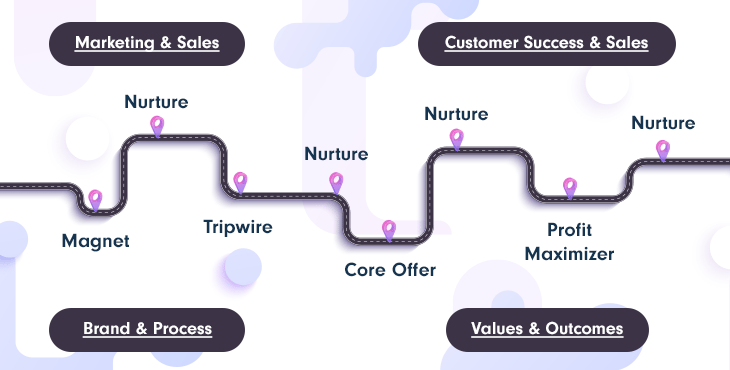
Ensure that your customers continue to be educated on the full extent of your product long after the official onboarding process is over.
Host webinars, send informative emails, and produce free tutorials. Customers want to feel like they are getting value for their money. And the more value they get from you, the more likely they’ll stay with your business long-term.
Final Thoughts on Reducing Customer Churn for Your SaaS Business
Unfortunately, you cannot completely avoid churn. You have to reduce customer churn for your SaaS business with a proactive, customer-centric strategy that you can scale up step by step using the tactics in this article. If you reduce your churn, you’re taking important steps towards making your business more profitable.
Aim for excellent customer retention and a low churn rate, and you’ll stand out from other SaaS businesses. Make sure you are not working with a payment provider stalling SaaS growth. Choose a partner that can provide you with the right tools and assistance to effectively fight churn. As always, PayPro Global is here to guide you through the process. Give us a shoutsell SaaS online if we can assist.
FAQ
What does it mean to reduce churn?
Churn is a metric that calculates how many customers have cut ties with your company during a given period.
How do you reduce customer churn?
(1) Invest in customer service. (2) Focus on improving retention rates. (3) Provide a better user experience.
What is a good churn rate?
SaaS companies that target small businesses should aim for a 3-5% monthly churn rate, while enterprise size businesses should be focussing on a churn rate of around 1% or less.
Why do customers churn?
The most significant cause of churn is when customers are not receiving enough value from the product or service to justify the expense.
Infrequent login or usage, requests for refunds due to changes in billing, dissatisfaction with product updates, and lack of loyalty benefits--all are sure signs that customers are unhappy.
Hanna Barabakh
Hanna Barabakh is a language and content specialist passionate about SaaS, technology, and e-commerce. Her expertise in multilingual content, connected to her background in Lexicography and Translation Studies, allows her to communicate complex ideas across cultures easily. She uses her knowledge to create engaging content that resonates with global audiences. In her spare time, she enjoys reading and exploring new ideas.
-
1.Explore PayPro Global's Solutions: See how our platform can help you streamline your payment processing and boost revenue.
-
2.Get a Free Consultation: Discuss your specific needs with our experts and discover how we can tailor a solution for you.
-
3.Download our Free Resources: Access valuable guides, checklists, and templates to optimize your online sales.
-
4.Become a Partner: Expand your business by offering PayPro Global's solutions to your clients.
Get the latest news


